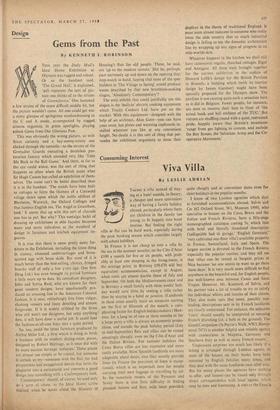Design
Gems from the Past
By KENNETH J. ROBINSON This was obviously the wrong picture, so with fierce curiosity and a hey-nonny-nonny one clicked through the turnstile—to the strains of the Grenadier Guards executing a doubtless pas- toralian fantasy which sounded very like 'Take Me Back to the Ball Game.' And there, as far as the eye could wince, was the sort of thing that happens so often when the British make what Sir Hugh Casson has called an exhibition of them- selves. The scene can't be better described than it is in the handout. The stands have been built as cottages to form the likeness of a Cotswold village down upon which the noble edifices of Blenheim, Warwick, the Oxford Colleges and that famous English inn, The Angel at Grantham, look.' It seems that up with this sort of charade one has to put. But why? This nostalgic habit of dressing up exhibitions in olde facades becomes more and more ridiculous as the standard of design in furniture and kitchen equipment im- proves.
It is true that there is some pretty nasty fur- niture in the Exhibition, including the latest thing in clumsy, ebonised undercarriages and brass- spatted legs with brass skids. But most of it is much better than the best-selling, chintzy, fringed bunchy stuff of only a few years ago. One firm (Stag Ltd.) has even brought its period furniture a little more up to date. Its consultant designers, John and Sylvia Reid, who are known for their, good modern designs, have unashamedly pro- duced an amusing line in the American Colonial fashion. It is neat, refreshingly free from vulgar, clashing veneers and fussy detailing and almost forgivable. If it is widely cribbed by the firms who still won't use designers, but copy anything new, it will have done a useful job. It could lead the fashion-at-all-cost boys into a quiet period.
So, too, could the latest furniture produced by Archie Shine Ltd., a firm which is doing as brisk a business with its modern dining-room pieces, designed by Robert Heritage. as it once did with its more ancient heritage 'antiques.' These pieces are almost too simple to be copied, but someone is certain to try—someone with the flair for bad proportions and exaggerated details that turns the plagiarist into a caricaturist and converts a good design into something with a Contemporary look.
'Contemporary' should, of course, be used only as a term of abuse, as the Ideal Home scribe realised when he wrote about the Ministry of Housing's flats for old people. These, he said, are 'up to the modern minute.' Did he, perhaps, pace nervously up and down on the opening day, stop-watch in hand, hoping that none of the spec builders in 'The Village in Spring' would produce wares described by that new breathless-making slogan, 'Absolutely Contemporary'?
The only exhibit that could justifiably use this slogan is the 'built-in' electric cooking equipment which Tricity Cookers Ltd. have put on the market. With this equipment—designed with the help of an architect, Alan Gore—you can have your. oven, hot plates and warming cupboards in- stalled wherever you like at any convenient height. No doubt it is this sort of thing that per- suades the exhibition organisers to dress their displays in the theme of traditional England. It must seem almost indecent to someone who really loves the olde country that so much industrial design is failing to toe the domestic architecture line by wrapping up any signs of progress in an olde-worlde skin.
Whatever happens in the kitchen we shall still have ceremonial regalia, thatched cottages, Elgar and Annigoni. All these were brought together for the current exhibition in the replica of Howard Lobb's design for the British Pavilion in Brussels, a building which (with its interior design by James Gardner) might have been specially prepared for the Olympia show. The pavilion is not causing quite such a sensation here as it did in Belgium. Fewer people, for instance, are seen to remove their hats in front of `the actual book and bell emblem of the TUC.' But visitors are shuffling round with a quiet, restrained pride, happily aware •that Britain's inventions 'range from gas lighting to cement, and include the Boy Scouts, the Salvation Army and the Co- operative Movement.'






































 Previous page
Previous page